Spatchcock Chicken is also known as butterflying – a technique of removing the backbone for a faster roasting time that results in juicy & flavorful chicken.
Spatchcock Chicken is just a fancy term for butterflying chicken. When you roast a whole chicken traditionally, you may need to nurse it to make sure that that all parts of the chicken are cooked evenly and thoroughly. In this Spatchcock Chicken recipe, the chicken is flattened so that the breast and legs are at the same level. This makes the chicken juicy, tender, and flavorful all around.
When you cook a whole chicken in the oven, the outside gets nice and brown first, then the inside takes a long time to cook all the way through. The breast meat is often dry and done when the thighs are done cooking. But there’s a simple trick you can use to cook the chicken faster and more evenly: spatchcocking. This is just a fancy word for “splitting” or “flying” the chicken.
What Is Spatchcocking?
Spatchcocking involves removing the backbone of the chicken and flattening it out so it looks kind of like a butterfly. By doing this, the chicken lays flat in one layer, which allows it to cook much faster and more evenly.
For this way of cooking chicken, the words “spatchcock” and “butterfly” can be used interchangeably. Spatchcock is just a more interesting word for the same thing: cutting out the backbone and flattening the bird.
Why Spatchcock a Chicken?
There are several excellent reasons to spatchcock chicken before roasting or grilling
-
Cooks faster: With the chicken flattened out in a single layer, it cooks in about half the time as a whole chicken. The heat can reach all parts of the meat directly.
-
Making it flat helps the dark leg and thigh meat and the white breast meat cook at the same rate. No more breasts that are dry while you wait for the thighs to dry!
-
Gets crispy skin When cooked whole parts of the chicken touching the pan don’t crisp up as nicely. Spatchcocking exposes all the skin to get super crispy.
-
Easier to season: You can easily season every bit of the meat when it’s butterflied open. No struggling to get seasoning under the chicken.
-
It can be hard to carve a whole cooked chicken, but it’s much easier to carve a spatchcocked chicken because it lies flat.
-
Takes up less oven space: A spatchcocked bird can lay flat in a baking sheet, unlike a whole chicken which takes up more vertical space.
How to Spatchcock a Chicken
Spatchcocking a chicken is surprisingly simple to do at home with just a pair of kitchen shears or strong scissors. Here is a step-by-step guide:
-
Place the chicken breast-side down on a cutting board. Locate the backbone running down the center.
-
Using sharp kitchen shears or scissors, cut along one side of the backbone, through the ribs.
-
Repeat on the other side of the backbone to completely cut it out. Set the backbone aside for making stock.
-
Flip the chicken over breast-side up. Press down firmly with your hands on the breastbone to flatten it. You should hear it crack.
-
Tuck the wing tips under the chicken body. This helps them cook evenly.
-
Season the chicken all over as desired. Rub the skin with oil to help it get crispy.
And that’s it – you have a spatchcocked chicken ready to roast or grill! It’s that simple.
How to Cook a Spatchcocked Chicken
A spatchcocked chicken can be cooked in the oven or on the grill. Just be sure to adjust the cooking time, as it will cook faster than a whole chicken.
To roast: Place the spatchcocked chicken breast-side up on a rimmed baking sheet. Rub all over with oil or butter and season well with salt and pepper. Roast at 450°F for 30-45 minutes until the thighs and breast meat reach 165°F.
To grill: Get the grill hot and oil the grates. Place the chicken skin-side down and grill over direct medium heat for 5 minutes per side until nicely charred. Finish cooking skin-side up over indirect heat, about 20-30 minutes more.
The chicken is done when the thickest part of the thighs and breasts reach 165°F. Let rest 5 minutes before cutting and serving. The meat should be juicy and delicious!
Spatchcocking Other Poultry and Birds
While chickens are the most common, you can actually spatchcock all types of poultry and birds, including:
- Turkey
- Duck
- Goose
- Game hens
- Squab
- Quail
Just use poultry shears to cut out the backbone and press to flatten them out. Adjust cooking times based on their size. Spatchcocking makes the birds cook quicker and more evenly.
Spatchcocking on the Grill
If you want to cook the spatchcocked bird entirely on the grill, that works great too. Get the grill nice and hot, then place the flattened chicken or other bird skin-side down to get crispy.
After flipping once, move it to indirect heat on the grill to finish cooking through without burning. Keep an eye on the temperature with a meat thermometer. This gives amazing smoky flavor!
Trussing vs Spatchcocking
Some people wonder how spatchcocking compares to trussing a chicken. Trussing involves using kitchen twine to tie up the wings and legs of the chicken to hold it all together. This can help the bird cook more evenly, but doesn’t provide the same benefits as spatchcocking.
Trussing doesn’t allow the chicken to lay flat, so it won’t cook as fast or get as crispy. It also doesn’t help the breast and thigh meat cook at the same rate like butterflying does. For best results, spatchcock instead of truss.
Get Spatchcocking!
Hopefully you now understand exactly what spatchcocking is all about and why it’s beneficial for cooking chicken and other poultry. With just a simple snip of the backbone, you can butterfly those birds for quicker and more even cooking. Crispier skin and juicy meat are only minutes away!
It’s an easy technique that can take your chicken dinners from good to fabulous. Don’t be afraid to get spatchcocking soon with this helpful guide. Your oven or grill is waiting for that flattened bird!
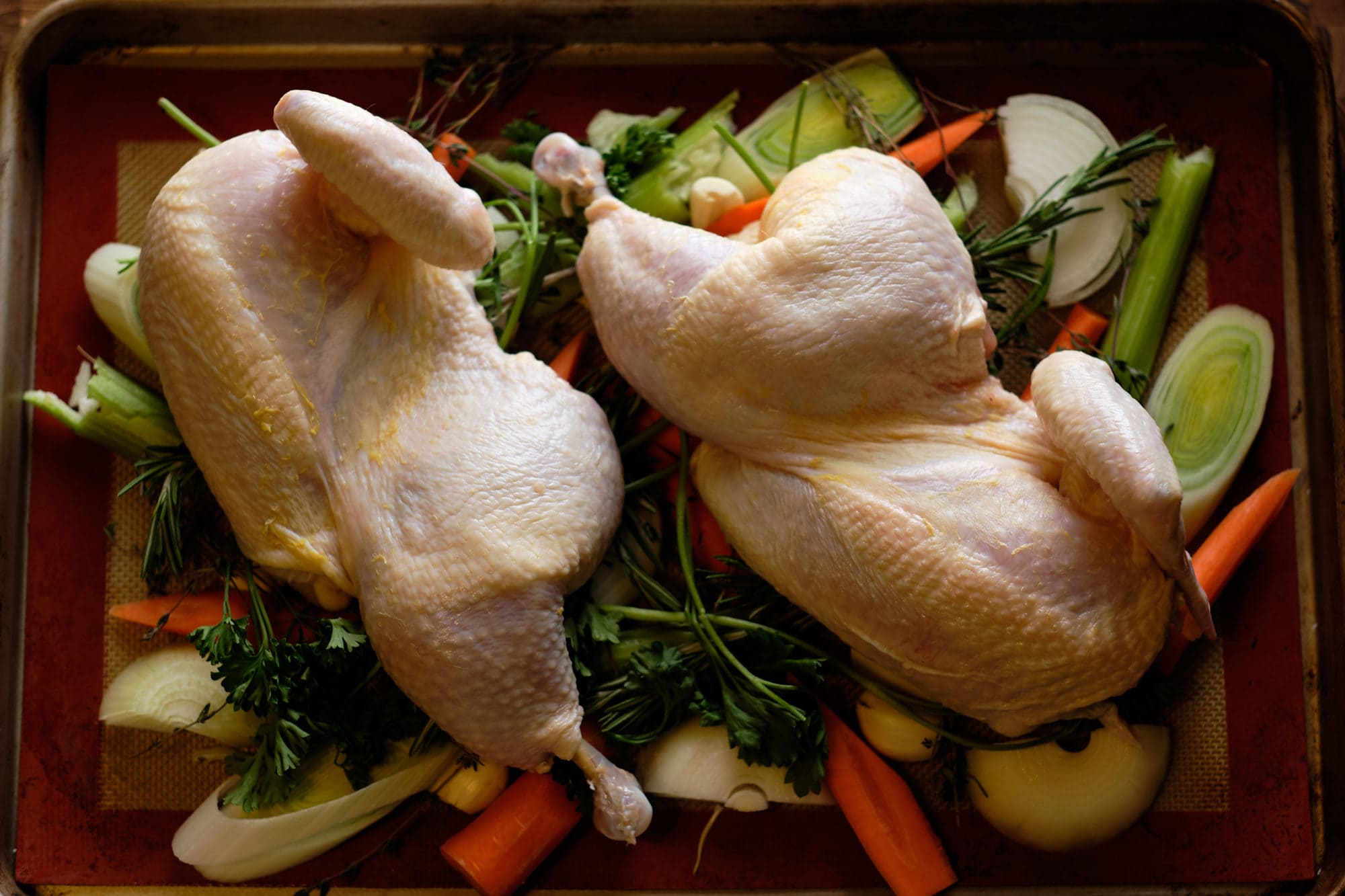
Spread the herbed butter on the spatchcock chicken
5. Flip the chicken over breast side up and set on the prepared rimmed baking half sheet. Use the palm of your hands to push firmly over the breast bone to allow chicken to flatten.
6. Use your thumbs to pull the skin from the meat.
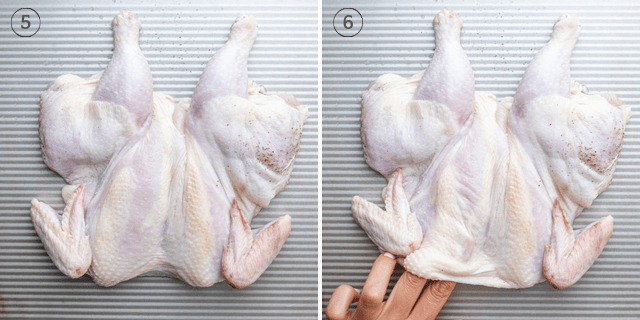
7. Now you’re ready to place the herbed butter mixture under the chicken skin. You can use a spoon or your fingers and make sure to press the skin down to distribute the butter.
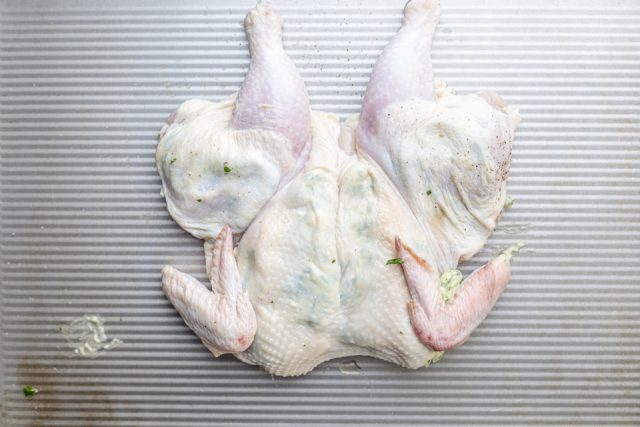
You’ll likely have extra herbed butter, and you can use that to dollop on top of the spatchcock chicken. Don’t worry about it being perfect because it’s going to melt and spread all over the chicken.
I highly recommend adding vegetables around the spatchcock chicken although it’s not exactly part of the recipe. The juices from the chicken create buttery crispy edges on the vegetables. And it’s possible you might even enjoy the vegetables more than the chicken! So don’t skip the veggies. You can add more olive oil and season with salt and pepper before baking in the oven.
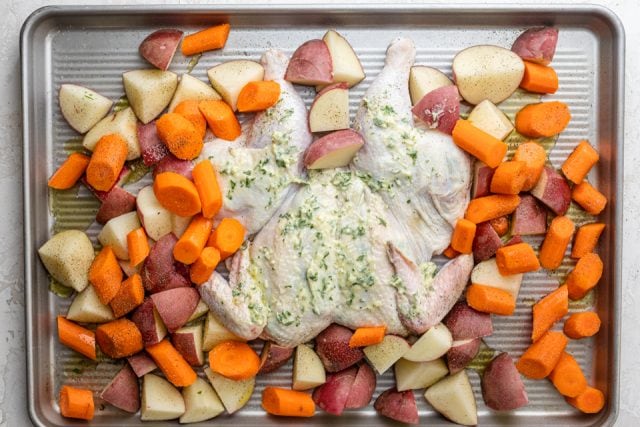
You’ll know it’s ready when the skin is browned and crispy and the internal temperature of the thickest part of the spatchcock chicken is 160˚F. When you remove it from the oven, let it rest for 10 minutes on the counter uncovered. This will allow all the juices to concentrate in the chicken to make it extra tender and moist.
Make the herbed butter
We’re going to use the herbed butter under the skin of the spatchcock chicken to make the breast extra juicy and get the skin browned and crispy. I use softened butter, olive oil, parsley, fresh garlic and lemon juice and mix them well together. You can use only butter or feel free to switch around the herbs and seasoning based on your preference.
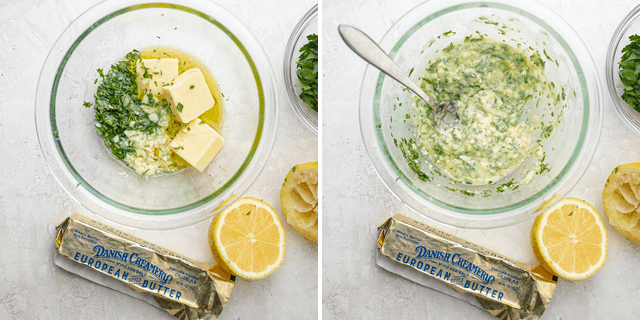
How To Halve A Chicken
FAQ
What is the point of a spatchcock chicken?
When you butterfly a chicken, the meat from the breast and the meat from the thighs are on the same horizontal plane. This means that they cook at about the same rate. This means no more waiting around for the thighs to finish cooking while the chicken breasts dry out.
What is the difference between butterflying and Spatchcocking?
Poultry is often butterflied. Butterflying makes poultry easier to grill or pan-broil. The more specific term spatchcocking refers to a variation on butterflying that also removes the backbone and possibly the sternum, typically from a smaller bird. Removing the sternum allows the bird to be flattened more fully.
How long does it take to spatchcock a chicken?
For 40 to 45 minutes, or until the thickest part of the thigh registers 165oF and the chicken is cooked all the way through, roast it. Let rest for 10 minutes before carving and serving.
